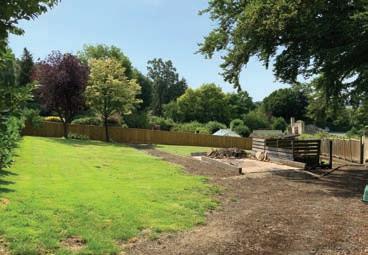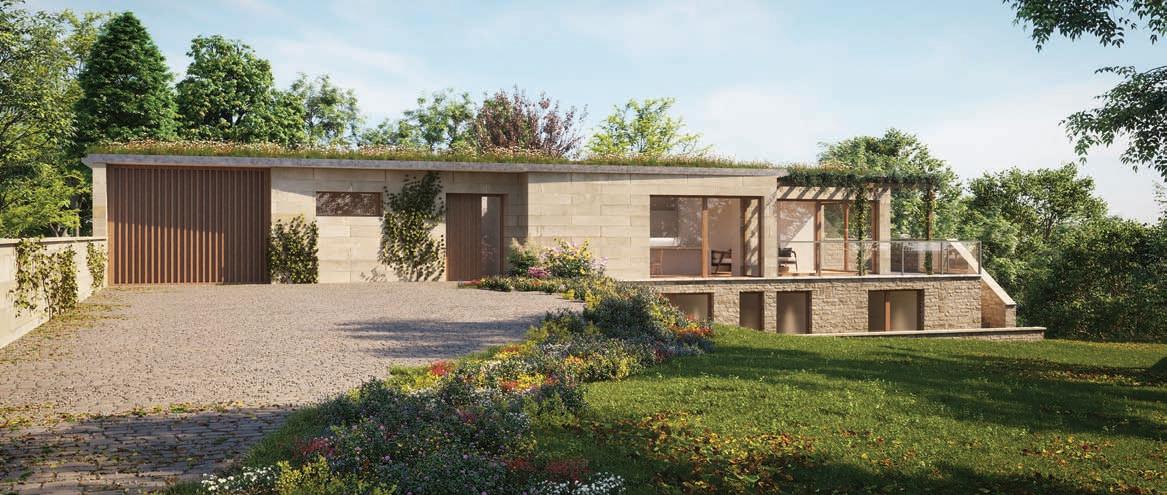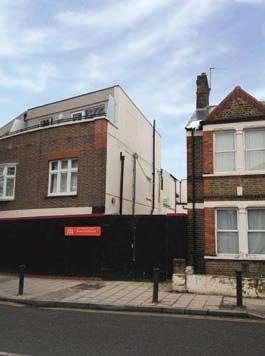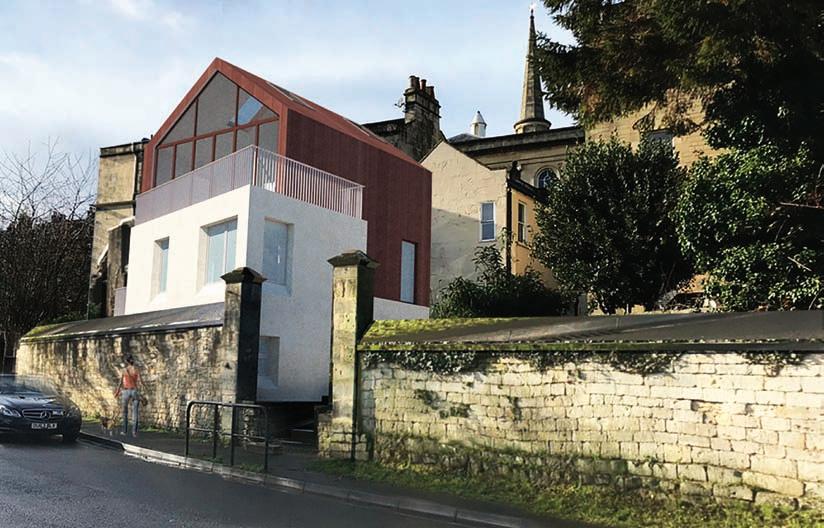
19 minute read
HOME DEVELOPMENT
A sustainable urban future?
How can we develop our city without detracting from its existing heritage? Richard Asbury, director of Bathbased Maack Architects, talks sustainable development, well-designed homes and conserving our green spaces
Advertisement
Richard Asbury
The economy is on the brink of collapse. Climate change is an existential threat to humanity. The planning system is broken. We need more houses. Whether you agree with these desperate cries or not, the government’s recent response to these crises has been to slash planning red tape and encourage us to “build, build, build”. This summer, Boris Johnson announce d sweeping reforms to the planning system and issued a white paper entitled Planning For The Future, which started a consultation period to look at how to make it easier to build better homes in England. While this announcement was music to the ears of developers and investors, it struck fear into the hearts of conservationists, preservationists and assorted guardians of our green and historic land.
So shou ld we be concerned? Bath and its surrounds are perhaps some of the greenest and most historic in the land. Surely, if we are being encouraged to build more, won’t it threaten our unique architectural and environmental heritage?
We ll, as ever, it’s not what you do, it’s the way that you do it. Some of us embrace progress, while others find it hard to accept changes to tradition. When it comes to building in our own backyard, however, it seems our inner NIMBY (Not In My Back Yard) is often awoken. We wish they’d just leave things alone, and if something has to be built then we want lots of rules and conditions to make sure that it doesn’t change the view from our window.
But, as anyone who has sought planning permission knows, the rules can be complex and cumbersome. The current system is slow, unpredictable, a nd perhaps more i mportantly, has not encouraged the supply of better quality, better-designed, sustainable homes. This is partly what the government reforms are trying to address. Likewise, this is where there are opportunities for individuals and small independent developers to change the way things are done. If we want to retain control of our cherished urban and rural environment, we need to lead by exam ple to create a better
BELOW AND RIGHT: This proposed new dwelling is situated on a sloping site on North Road. The two storey house is designed to Passive House standards and built into the site to minimise impact on the views from adjacent properties
e nvironment – this means we should be involved in developing it ourselves.
While the proposed changes to the planning system are arguably the most radical since the introduction of the Town and Country Planning Act in 1947, it’s interesting to remember that most of Bath and the surrounding towns and villages were built before any national planning policy even existed.
We all know that B ath’s origins lie, according to legend, with its founding around 860BC when Prince Bladud (the ‘real-life’ father of Shakespearean King Lear) had his leprosy cured by the mud of the hot springs. The Romans, who loved a good mud treatment, saw the benefits and subsequently built a settlement around 50AD called Aquae Sulis. The Romans also liked nice regular streets laid out on a grid and used strict architec tural codes for the design o f their buildings – perhaps the first planning restrictions that Bath had seen. When the Romans eventually left, their regular street pattern gave way to less well-planned medieval streets. Buildings were packed closely together and designed more according to need and available skill and materials – architecture without architects.
The medieval market town then smartened up itself up for the tourist trade and


ABOVE AND LEFT: This innovative three bedroom new-build town house occupies a previously disused alleyway that was only three metres wide. It has been designed using sustainable materials and construction throughout. The super-insulated house is designed to radically reduce energy consumption and is built with a


breathing wall construction system that uses natural, low-carbon renewable materials to ensu re there is very low waste. The external finish is Douglas Fir cladding, a UK-grown durable softwood treated with a lowmaintenance environmentally sound stain which gives the house its striking appearance
reinvented itself into a fashionable Georgian health spa. New innovative and radical forms of town planning were used focussing on harmony, views, and a formal uniform architectural style. These grand elegant buildings were designed to look like single palatial residences but were often actually purpose-built lodging houses, divided, subdivided and subdivided again according to function – and purse! Tourist s and visitors could rent a room, a floor, or perhaps even an entire house and be looked after by the communal staff.
To maintain a uniform appearance many of these buildings were constructed according to a masterplan by small-scale, speculative developers who made and lost fortunes by leasing plots from the landowners and building on them.
T he great expansion of the city into the suburbs came when the devel opment of p rivate housing was supercharged during the inter and post-war years. A national review of housing identified the inadequate state of dwellings in much of Bath, which had turned into insanitary slums. This led to the wholesale clearance and development of large areas of the city – the so-called ‘Sack of Bath’. The redevelopment of the city in the 1960s and 1970s was said by some to have inflicted more damage on the city than the B ath Blitz of 1942. Development spread beyond the city boundaries, facilitated by long-term financing and mortgages, to incorporate surrounding villages such as Twerton, Combe Down and Weston in a post-war style, and has since been kept in check by the Bath and Bristol Green Belt.
This hasty romp through Bath’s fascinating architectural history can be explored in more detail by a trip to the Museum of Bath Architecture – Covid-19 restrictions allowing–and I’d strongly urge you to visit – but now back to the present.
Tourists may love the identical classical frontages and homogenous honey-coloured Bath stone, which, despite the different architectural styles, creates so much of the city’s character. But they are just that, a façade. The real interest and story is what lies beh ind the façades: at the back of houses, between buildings, in the mews, gardens, alleys and side streets. This is where you really begin to understand how Bath developed –the spaces between, the spaces b ehind and the spaces above. And just like the medieval merchants who adapted their Roman predecessors’ spaces to suit their lifestyles and need, it is these leftover spaces in the present city that provide the opportunity to develop and continue the evolution of the city in a sustainable way.
New sites to build on aren’t always easy to find, and although sometimes they are hiding in plain sight, over the last 60 years the easiest sites have been developed. So now it’s time to look at how we could use the backlands, the badlands, the derelict sites, the brownfield sites, the gardens, yards, roads and alleys. These forgotten, unused or difficult sites are the ones that commercial developers and house builders often overlook because they ➲
ABOVE: This new build five-bedroom family house is designed to fit within the historic context of a Conservation Area. The house redevelops an existing brownfield site, and completes the elegant Victorian frontage. Inside, five bedrooms, four bathrooms, and large reception and entertaining spaces are laid out over three floors


require too much investment or time to unlock their potential, but we have found that it is exactly these gaps and the voids in our urban fabric sites that offer opportunities for development on a small scale.
I have learned from experience to spy a site, unnoticed or discarded as too challenging, too expensive. The owners of such sites m ay not know what an asset they h ave, but with the help of an architect’s skill and creative thinking such sites can be unlocked to release value for owners while going some way to meeting the housing need. The optimum situation should be a win-win situation where owners receive a cash windfall whilst individual self-builders, small independent developers or perhaps a housing co-operative are encouraged to build decent q uality, sustainable new homes.
We know that Bath is particularly sensitive to redevelopment, being rightly proud of our unique architectural heritage and UNESCO World Heritage Status, so any new development needs to be sensitive and sustainable – adding to a legacy of good domestic architecture and continuing the great architectural heritage of our city. As architects our experience has shown u s that small new developments perhaps need to take even more care about how, where and what is built than large developments. New buildings need to engage with the community, to listen and address concerns. They need to take a sustainable approach to the environment and materials such as looking at using Passive House design principles, which are designed to attain a quantifiable and rigorous level of energ y efficiency to reduce energy use. Of course it is vital to consider involving an architect at an early stage to help find the best solution for unlocking the potential of such sites and leaving them in a better state than we found them.
I believe that small one-off buildings and new developments have great potential to lead by example and create exemplary homes that make a positive contribution to the cit y. I ndividual and small developers maintain a strong presence on ground and in the community so it’s within their interest to build the best possible houses they can. At Maack Architects, we have created many new homes on challenging sites: alleys, gardens, garages, derelict buildings and wasteland, so I know that there are opportunities to build providing you have enough vision, tenacity and patience. It’s not a quick or easy journey, but it is infinitely rewarding and increasingly vital. ■
Richard Asbury is director of Maack Architects and an architect who also develops houses. He has helped private clients and developers to maximise the potential of their land and properties by creating new sustainable homes; call for a free consultation: maack.co.uk




397 Lots, including: CNC EQUIPMENT: YAMAZAKI Slant Turn 25 Universal 1500. XYZ 4000 CNC Turret Mill with Proto Trak AGE 3 Axis. DRILLING: QUALTERS & SMITH Model R3 Radial Arm. RICHMOND SR2 Radial Arm. ELLIOTT Pillar Drill. GRINDING: SNOW 72” x 15” Vertical Spindle Surface Grinding Machine. DORMER ZBM80 Drill Point Grinder. LATHES: DEAN SMITH & GRACE SB 1810 x 72” Hardsgyde Straight Bed. COLCHESTER Tri umph 2000 x 30” Gap Bed. COLCHESTER Tr iumph 2000 x 50” Gap Bed. 2 x HARRISON 12” x 24” Straight Bed. COLCHESTER Bantam 2000. MILLING MACHINES: RAMBAUDI MS3P Horizontal/Vertical Turret Mill with Newall DRO. CINCINNATI Turret Mill with Newall DRO. Rambaudi Versamill 12 Milling Machine with Newall DP700 DRO. SAWING MACHINES: MEBA Eco-line Model 335 DG Horizontal Bandsaw. RUSCH Horizontal Bandsaw. TRENNJ AEGER ST251 C old Saw OSMOND Chop Saw with Mitreing. WICKSTEED Power Hack Saw. SPEEDAX 20” Vertical Bandsaw. SLOTTING: SACHMAN SYNCHRON 225mm Slotting Machine. BUTLER 10” Slotting Machine. SHEET METAL: KEETONA Hydroform 2540mm x 3mm Folding Machine. WELDING EQUIPMENT: ESAB LAX320 Mig Welder with ESAB MEK Wire Feed Unit. ESAB LAR500 Mig Welder with ESAB Wire Feed Unit. ESAB LAW 410 Mig Welder. KEMPPI Ma ster T IG MLS 3003AC/DC. KEMPPI FastMig M420. OXY Acetylene Set with Gauges, Hoses & Trolley. INSPECTION: FARO Gage Plus Inspection Arm (2007). Large Selection of Inside/Outside Micrometers MISCELLANEOUS: SWEENEY & BLOCKSIDGE No.8 Flypress. PELLOBY Free Standing Jib Crane 1.6 Ton SWL. Several Jib Cranes. FORKLIFTS: 4 x LANCER BOSS Side Loaders. COMPRESSORS: HYDROVANE Model V11 ACE08- 4035V400 Screw Compre ssor complete with A ir receiver. HYDROVANE 711 Classic Screw Compressor. HYDROVANE 60 Screw Compressor. GENERATOR: DORMAN/STAMFORD Diesel Generator

















CITYNEWS
TOP RANKING

Private Client Partner at Mogers Drewett, David Hill, has b een r ecognised by the prestigious Chambers High Net Worth Guide for the second year in a row. Published every July, Chambers independently researches lawyers across the UK by interviewing clients and accessing the quality of work and then ranking the top performing lawyers in its High Net Worth Guide.
Hill’s practice includes estate and succession planning matters, and a client says he “gives the impression that nothing is too much trouble”. A professional a dviser says: “From my personal observation he relates well to his clients and expresses himself to them in a written form which is comprehensive and fully understandable.” md-solicitors.co.uk
TOP-LEVEL HOME CARE
Abney & Baker, a care at home company providing support across Bath, North East Somerset and West Wiltshire, has been awarded the prestigious homecare.co.uk Top 20 Home Care Group Award 2020. The award is recognition that Abney & Baker is one of the most recommended Home Care Groups in the UK based on over 14,000 published reviews between 1 May 2018 and 30 April 2020 from those receiving home care as well a s their friends a nd family. Abney & Baker’s West Wiltshire branch ranked 9.8 and their Bath & North East Somerset branch ranked 9.6 from client reviews. The company prides itself on the way it treats all its employees, with the respect and support they deserve to deliver the best service possible to their loyal clients; abneyandbaker.com
MACHINERY ONLINE AUCTION

Machinebidder – who offer an online auction platform for the sale of industrial assets – is running an auction for the sale of plant and machinery in early October further to the retirement of the directors of RHG Stone Engineering Ltd. Each lot has a photograph and a technical description and appears online for bids from the UK and worldwide. Once buyers have completed the registration process, bids can be placed 24 hours a day from anywhere in the world. The auction includes lots such as a Swing Beam Hydraulic Guillotine (see right), a Vertical Machining Centre, a Universal Grinding Machine and a Hydraulic Downstroking Pressbrake. View the works at 121 Main Street, Walton, Somerset BA16 9QL, strictly by appointment; tel: 0161 345 3000. machinebidder.com
DOUBLE TREE OPENS ITS DOORS
DoubleTree by Hilton, Bath will finally open its doors on 1 October 2020 after a major £10.1 million redevelopment programme. Located on Walcot Street, the hotel boasts a unique position overlooking the River Avon and the weir from which the refurbishment of all 176 hotel rooms and public spaces has drawn its inspiration.
The new-look hotel now boasts the intimate Secret Garden, a unique orangerie which overlooks the river, the perfect spot for visitors to experience two of Bath’s favourite past times – taking in the view and Afternoon Tea. Other hotel facilities include a stylish Bar and Restaurant and a separate café area, complete with an outdoor terrace dining area, as well as a private gym and state-ofthe-art meetings and events space. Chris Cottam, General Manager, said: “These are exciting ti mes for Bath and for our staff who have been eagerly awaiting this hotel’s transformation. The DoubleTree by Hilton Bath is now one of the biggest hotels in the city with 176 Scandi-style rooms, private gym and an impressive meetings and events space that can house up to 200 people theatre-style. dtbath.doubletreebyhilton.com
NEW NAME, NEW GROWTH
Leading south west commercial property consultancy Colston & Colston has rebranded as CSquared. The rebrand better reflects their modern, forward-thinking and dynamic approach. Started in 2008 and head quartered in Bath, CSquared is a multi-disciplinary practice offering commercial property agency, valuation, building surveying, and property management.
The company’s recent growth includes the opening o f a new office in Bristol, plus a further one in Cheltenham before the end of the year, and expansion of their service offering. The business prides itself on providing a tailored, personal client service. CSquared focus on getting to know their clients and the challenges they face with their property requirements so that they can deliver partner-led, bespoke solutions that produce tangible results.
Pa rtner Allan Lloyd said: “Our re-brand represents our modern and innovative ways of working. While we deal in commercial property, it is people that drive the market – no two clients are the same and it is our personal service and connection with our clients that has made our business a continuing success story.” csquaredre.co.uk

UPDATE YOUR WILL
The Forever Friends Appeal is running its annual Will Writing initiative during November. RUH Will Month raises awareness of the importance of making a will and generates funds to support patients and staff at the Royal United Hospitals, Bath through its charity. Legal firms, Helen Starkie solicitor, Mogers Drewett solicitors, Royds Withy King, Bath Wills and McClure are those who will offer their time and expertise. Waiving the original cost of a will, they are offering their services at a discounted price of £125 for a single will or £175 for a joint will and donating their fees directly to The Forever Friends Appeal to support the work of the RUH. foreverfriendsappeal.co.uk
ocl A C C O U N TA N C Y
141 Englishcombe Lane, Bath BA2 2EL Tel: 01225 445507 www.oclaccountancy.com
When is a van a car?
The Court of Appeal has finally ruled on the tax status of certain vehicles and the result can significantly change the tax liability of the drivers.
In the Coca Cola case the Court upheld HMRC’s opinion that vans with windows and a second row of seats behind the driver are not goods vehicles but cars for tax / benefit purposes. Going forward if the ruling is unchallenged by Coca Cola it could set a legal precedent which may result in drivers paying higher tax and national insurance than they would if the vehicles had been classed as ‘goods vehicles’.
The legislation defines a goods vehicle as one of a construction primarily suited for the conveyance of goods. The tax tribunal determined that modified VW Kombi vans failed this text and it has subsequently been decided that the Vauxhall Vivaro should also be taxed as a car for P11d benefit in kind purposes.
The result is that where the vehicle is available for private use, the driver will have a taxable benefit based on the original list price multiplied by a percentage based on the vehicle’s CO2 emissions. Employers may need to reconsider providing such vehicles going forward, together with reviewing their P11d reporting.
To make matters more confusing, the benefit in kind rules are not the same as the rules for the recovery of input VAT on vehicles and we would all benefit from a common definition for tax purposes.
For tax saving tips contact us – call Marie Sheldrake, Tom Hulett or Mike Wilcox on 01225 445507
Should you Equity Release?

The last few months have seen many people furloughed or sadly being made redundant and therefore struggling financially. As a result, equity release has risen in popularity as an option to provide financial relief.
What is Equity Release?
The equity you hold in your property is the difference between the property value and the amount of debt you have secured against the property. An equity release plan will allow you to access some of this equity.
How does it work?
An equity release provider will provide you with either a lump sum or an income in exchange for part of the value of your home. This is achieved either using a type of mortgage, or by selling that portion of your home on the condition that you can continue to live there as long as you wish.
The minimum age for applying for an equity release plan is 55 and the debt only needs to be repaid from the sale of the property either on death of the last applicant, or the last applicant entering a care home.
Why release equity?
You can use the funds released from an equity release arrangement for a variety of different reasons and could include:
• Topping up your income • Helping children and grandchildren • Renovating or refurbishing your property • Buying a second property • Paying for holidays • Adapting the home • Funding hobbies and interests
Equity release is not for everyone
Make sure you speak to an independent financial adviser or mortgage broker specialising in equity release to receive unbiased advice on whether it really is the best option for you and to ensure you are protected from pitfalls like negative equity.
What to do next
Get in touch, call 01225 308333 or email Sean.McCabe@mogersdrewett.com, our advisers all have the required equity release qualifications and are accredited by The Society of Later Life Advisers.
Call Marie Sheldrake, Tom Hulett or Mike Wilcox on 01225 445507 to arrange a no-obligation meeting











